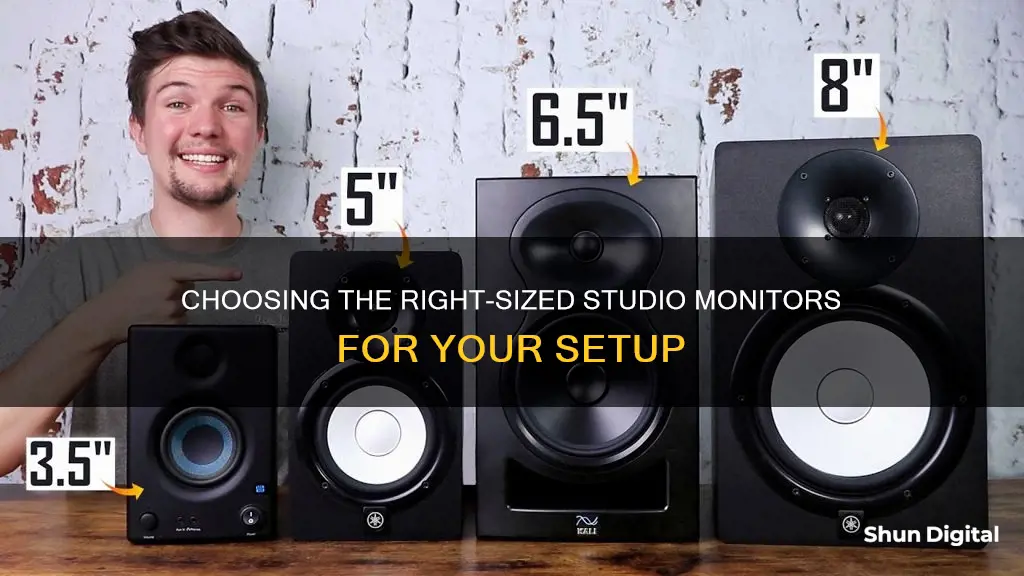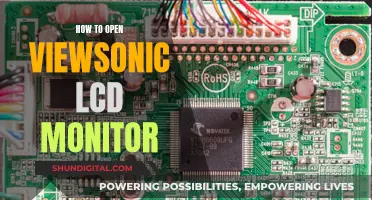
Studio monitors are a crucial piece of equipment for anyone looking to create music in a professional manner. The size of your studio monitor will depend on a variety of factors, including the size of your room, the type of monitor, and your budget.
The size of your room is crucial for achieving good sound quality. The bigger the room, the larger the monitor should be. If you have a room that is approximately 4x4x2.5m in size, 8 monitors are recommended. For smaller rooms, 5 monitors are more suitable and are also the most convenient option. However, they will not allow you to work on low frequencies and are typically meant to be used with a subwoofer.
Another factor to consider is the type of monitor. Active monitors are more suitable if you are looking for professional-level sound quality as they have built-in amplifiers and crossovers, whereas passive monitors tend to be modular and require additional equipment.
Additionally, the power of the monitor will affect the end product of your mix, impacting both the volume and dynamic range. A higher wattage will allow you to hear transient details more clearly and make precise adjustments.
When choosing the size of your studio monitor, it is important to consider the size of your room, the type of monitor, and your budget. Taking these factors into account will help you achieve the best sound quality for your setup.
What You'll Learn

Studio monitors are not regular speakers
Regular speakers, on the other hand, are typically biased to emphasise certain frequencies, such as adding more bass or treble to music. This is done to create an enhanced and enjoyable listening experience for the audience. However, this can be misleading when trying to create a balanced mix, as it may trick you into thinking your mix is well-balanced when it is not.
Studio monitors are designed to reproduce frequencies as accurately as possible. They are used to mix music, dialogue, and sound effects during the recording, mixing, and mastering process. They are an essential tool for producers, engineers, and other audio professionals who need to make informed decisions about the sound.
In terms of construction, studio monitors tend to be active, meaning they have built-in power amplifiers. Hi-fi and other home speakers are generally passive, receiving power from a dedicated standalone amplifier. Additionally, studio monitors often have multiple power amplifiers in one unit, allowing for individual power to the woofer (bass), midrange, and tweeter (treble) cones, resulting in a more precise sound.
The size of studio monitors should align with the room size and music style. For home studios, 5-inch speakers are generally recommended. If you work with music that requires better low-frequency response, such as EDM, larger speakers (8-inch or bigger) would be more suitable.
In summary, while studio monitors and regular speakers may look similar, they serve very different purposes. Studio monitors are designed for critical listening and accurate reproduction of sound, while regular speakers are meant to enhance the listening experience by emphasising certain frequencies.
Touch Monitors: Worth the Investment?
You may want to see also

Active vs passive monitors
When choosing the right studio monitors, you'll need to consider the size of your room and the style of music you produce. For home studios, 5-inch monitors are a good fit. If you're working with EDM, for example, you'll need a better low-frequency response, so a bigger driver size would be more suitable.
Now, when it comes to active vs passive monitors, there are a few key differences to note. Passive monitors are modular, requiring you to match them with amplifiers and crossovers, whereas active monitors have these built-in, making them more convenient and offering slightly better performance. Active monitors are also simpler to set up and don't require any additional equipment, making them a plug-and-play solution. On the other hand, passive monitors offer more flexibility as you can choose external amplifiers to match your monitors.
In terms of sound quality, active monitors are considered superior if you're looking for professional-level sound. They offer optimised power amps for each driver, optimised driver-protection circuitry, and short and direct connections between amps and drivers. They also tend to have a more accurate frequency response and greater definition. However, passive monitors have their advantages too. One benefit is the ability to upgrade the two components of your monitoring system separately – the speakers and the amp. This allows for a more gradual and cost-effective progression to better-quality gear.
So, which one should you choose? If you want a simple, reliable, and accurate setup, active monitors are a good choice. But if you're looking for more flexibility and are willing to put in a little extra effort, passive monitors might be better. It really depends on your specific needs and preferences.
Differentiating Monitor Resolutions: 480x720 vs 800x480
You may want to see also

Power and its effect on sound
When it comes to studio monitors, power has a significant effect on the end product of every mix. Aside from its impact on volume, power also determines the dynamic range of the record. Higher wattage means you can hear transitory details and make precise adjustments to compressors, limiters, and gates. Power is also crucial in determining headroom, which is the difference between the typical operating level of audio equipment and the maximum level it can handle without distorting.
Studio monitors come in different amplifier configurations: single-amp, bi-amp, and tri-amp. The single-amp configuration is the simplest, with a single amplifier powering both the left and right speakers. In the bi-amp configuration, there are two amplifier modules in each speaker, allowing for greater control over the frequency response and more precise sound reproduction. The tri-amp configuration is the most advanced, with each driver in a 3-way speaker system having its own dedicated amplifier. Bi-amp and tri-amp configurations generally offer a flatter and more accurate frequency response, resulting in a more powerful sound.
The power requirements of your studio monitors will depend on the size of your room and the type of work you are doing. For a small to medium-sized room, a studio monitor with 50-75 watts per channel is usually sufficient. However, for larger commercial studios, you may need monitors with higher wattage, such as 100 watts or more per channel. It's important to note that higher wattage doesn't always mean better quality; a well-designed, high-quality studio monitor with lower wattage can often outperform a cheaper monitor with higher wattage.
In addition to power, other factors such as driver quality, amplifier power, and speaker placement also play a significant role in the overall sound of your studio setup.
Performance Monitor's Highlight Tool: How It Works
You may want to see also

Speaker size vs room size
The size of your room will be crucial for good sound quality. The bigger the monitor, the larger the room should be. If your room is higher than 4x4x2.5m, you can use 8" monitors. A room that is 5x5x3m in size is perfect for 8" monitors. If you don't have access to such a big room, you should purchase 5" monitors.
If the room is much bigger than 4x4x2.5m, you may have reverb issues. 5" monitors are the most convenient, but they won't allow you to work on low frequencies. They are meant to be used with a subwoofer. 8" monitors are more expensive, but they allow you to work on low frequencies. They also have a good quality-price ratio.
The size of the studio monitor driver depends on the room size and the music style you work with. If you are an EDM music producer, for example, you will require a better low-frequency response, and therefore a bigger driver size would be more suitable. This is because larger speakers are capable of moving more air, which is necessary for reproducing lower-frequency sounds.
On the other hand, smaller speakers may offer better midrange and high-frequency response, as they can reproduce these frequencies more accurately due to their smaller size.
Speaker placement is also important. The position of the speaker has a huge influence on how the room responds to the signal.
In a small room, nothing will ever sound ideal. Acoustic issues are more important as the size of the room decreases. This is why large rooms are used in mastering, even though not a lot of equipment is required.
In a small room, because room modes combine in clusters, you would need a lot more absorption than in a larger room, but you just don't have the space to fit that much absorption. This is why you can't get a good response, and that has nothing to do with the size of the speakers.
That being said, if the room is tiny and the speakers are huge, you just won't be able to place them in a convenient spot, so there is a correlation to some extent. But bigger speakers causing more acoustic issues than smaller ones in the same room is a myth.
Troubleshooting ASUS Zen AIO Monitor Sleep Issues
You may want to see also

Speaker placement
The placement of your studio monitors is crucial to achieving optimal sound. Here are some tips to consider:
- Symmetry is important. Place your monitors symmetrically along the short wall of the room to minimise sonic reflections and ensure a balanced sound.
- Position the tweeters of your speakers at head height (ear level) so that your ears are directly in front of the speakers. This will give you the most consistent and accurate sound.
- Avoid reflections from nearby hard surfaces such as windows, drywall, mirrors, or any non-absorptive surfaces. These reflections can alter the sound through a phenomenon called comb filtering. Use absorption materials on reflective surfaces if necessary.
- Adjust the monitors to sound correct. Play music that you know well and adjust the monitors until they sound accurate. Move them away from boundaries (walls, corners, etc.) to reduce excessive bass. Use any available adjustments on the speakers (such as high-frequency/low-frequency boost/cut) to fine-tune the sound to your liking.
- Place your monitors on stands with isolation pads to minimise sound distortions.
- The size of your speakers should be appropriate for the size of your room. Smaller monitors are more suitable for smaller spaces.
- The ideal listening position forms an equilateral triangle with the two monitors. This ensures the most accurate frequency response and clearest stereo image.
- If you're setting up a multi-channel surround sound system, consult an expert for advice on speaker placement.
- Consider the distance between the monitors and the wall. Reflections from the wall can cause cancellations and affect the quality of sound. Placing the monitors close to the wall or using acoustical treatment can help mitigate this issue.
- If you're using a subwoofer, consider its placement in relation to the monitors and the listening position. In a typical setup, the subwoofer is placed along the front wall, slightly off-centre, with the monitors angled towards the listening position.
Setting Up Studio Monitors: Soundcraft MTK 22 Guide
You may want to see also
Frequently asked questions
If you have a small room, you should opt for smaller studio monitors. A pair of 5-inch monitors should be sufficient for a regular room at home.
If you have a medium-sized room, you should consider getting a pair of 6-8 inch studio monitors.
If you want to produce low frequencies, you should opt for larger studio monitors, such as 8-inch monitors, as they are capable of producing low frequencies.







